FORD F750 2015 13.G Owners Manual
Manufacturer: FORD, Model Year: 2015, Model line: F750, Model: FORD F750 2015 13.GPages: 384, PDF Size: 4.95 MB
Page 201 of 384
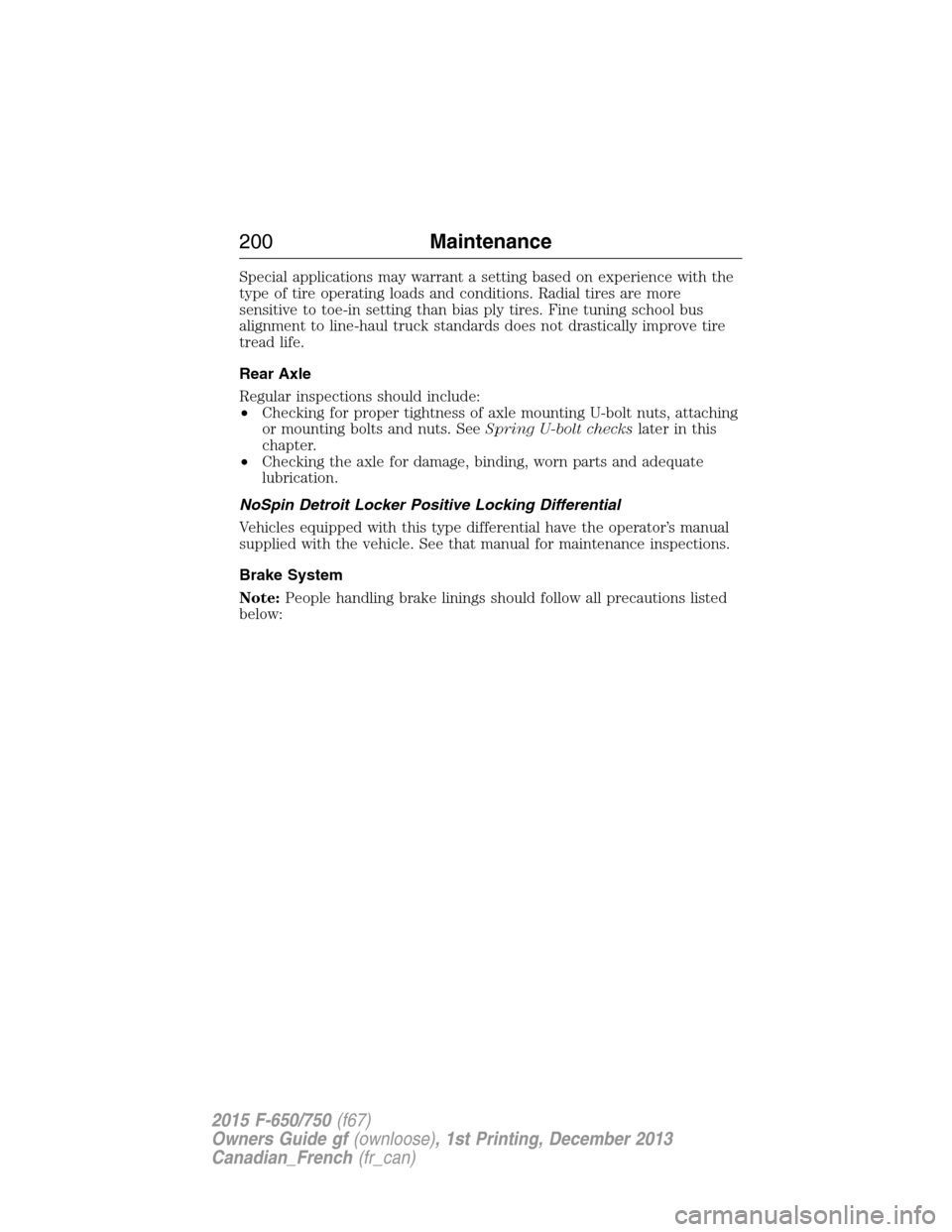
Special applications may warrant a setting based on experience with the
type of tire operating loads and conditions. Radial tires are more
sensitive to toe-in setting than bias ply tires. Fine tuning school bus
alignment to line-haul truck standards does not drastically improve tire
tread life.
Rear Axle
Regular inspections should include:
•Checking for proper tightness of axle mounting U-bolt nuts, attaching
or mounting bolts and nuts. SeeSpring U-bolt checkslater in this
chapter.
•Checking the axle for damage, binding, worn parts and adequate
lubrication.
NoSpin Detroit Locker Positive Locking Differential
Vehicles equipped with this type differential have the operator’s manual
supplied with the vehicle. See that manual for maintenance inspections.
Brake System
Note:People handling brake linings should follow all precautions listed
below:
200Maintenance
2015 F-650/750(f67)
Owners Guide gf(ownloose), 1st Printing, December 2013
Canadian_French(fr_can)
Page 202 of 384
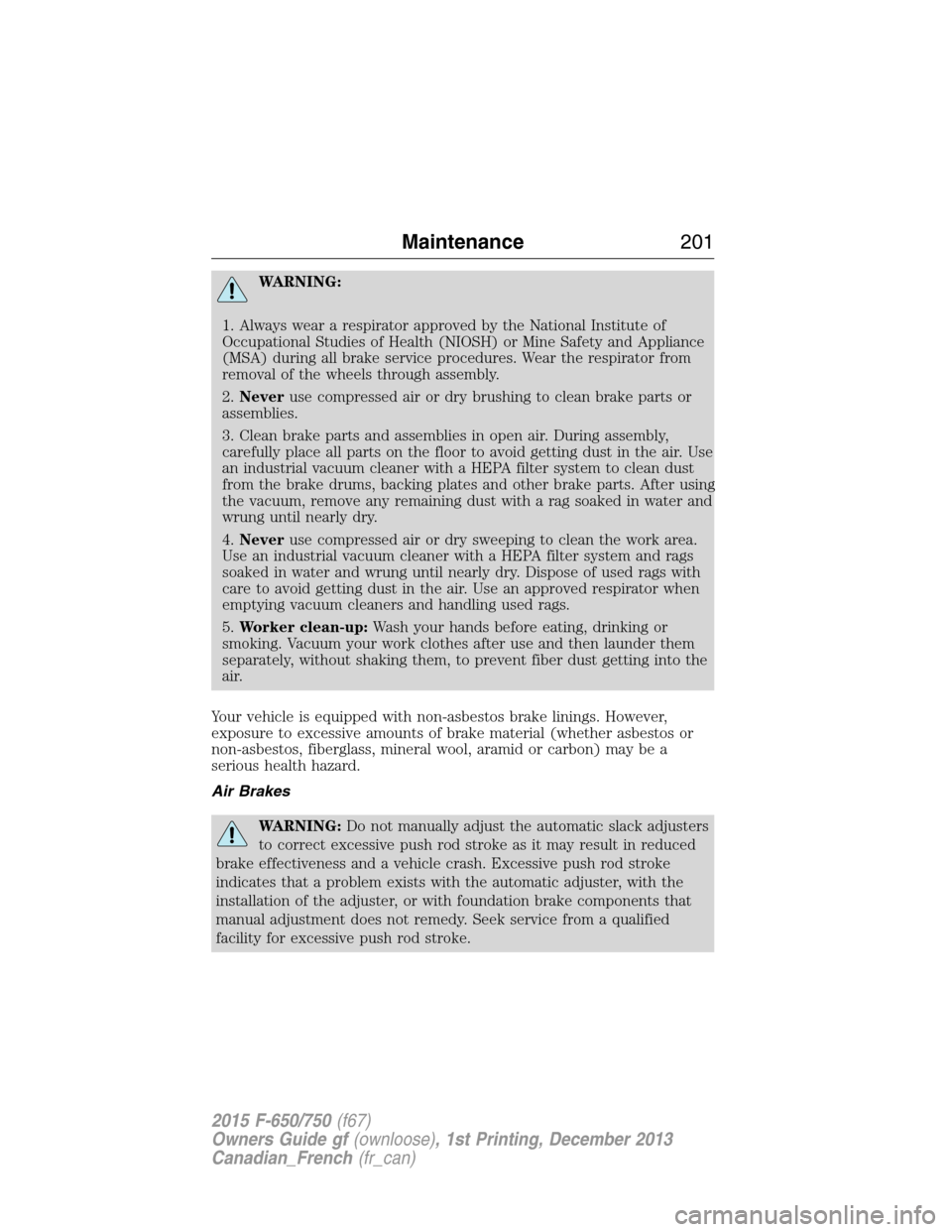
WARNING:
1. Always wear a respirator approved by the National Institute of
Occupational Studies of Health (NIOSH) or Mine Safety and Appliance
(MSA) during all brake service procedures. Wear the respirator from
removal of the wheels through assembly.
2.Neveruse compressed air or dry brushing to clean brake parts or
assemblies.
3. Clean brake parts and assemblies in open air. During assembly,
carefully place all parts on the floor to avoid getting dust in the air. Use
an industrial vacuum cleaner with a HEPA filter system to clean dust
from the brake drums, backing plates and other brake parts. After using
the vacuum, remove any remaining dust with a rag soaked in water and
wrung until nearly dry.
4.Neveruse compressed air or dry sweeping to clean the work area.
Use an industrial vacuum cleaner with a HEPA filter system and rags
soaked in water and wrung until nearly dry. Dispose of used rags with
care to avoid getting dust in the air. Use an approved respirator when
emptying vacuum cleaners and handling used rags.
5.Worker clean-up:Wash your hands before eating, drinking or
smoking. Vacuum your work clothes after use and then launder them
separately, without shaking them, to prevent fiber dust getting into the
air.
Your vehicle is equipped with non-asbestos brake linings. However,
exposure to excessive amounts of brake material (whether asbestos or
non-asbestos, fiberglass, mineral wool, aramid or carbon) may be a
serious health hazard.
Air Brakes
WARNING:Do not manually adjust the automatic slack adjusters
to correct excessive push rod stroke as it may result in reduced
brake effectiveness and a vehicle crash. Excessive push rod stroke
indicates that a problem exists with the automatic adjuster, with the
installation of the adjuster, or with foundation brake components that
manual adjustment does not remedy. Seek service from a qualified
facility for excessive push rod stroke.
Maintenance201
2015 F-650/750(f67)
Owners Guide gf(ownloose), 1st Printing, December 2013
Canadian_French(fr_can)
Page 203 of 384
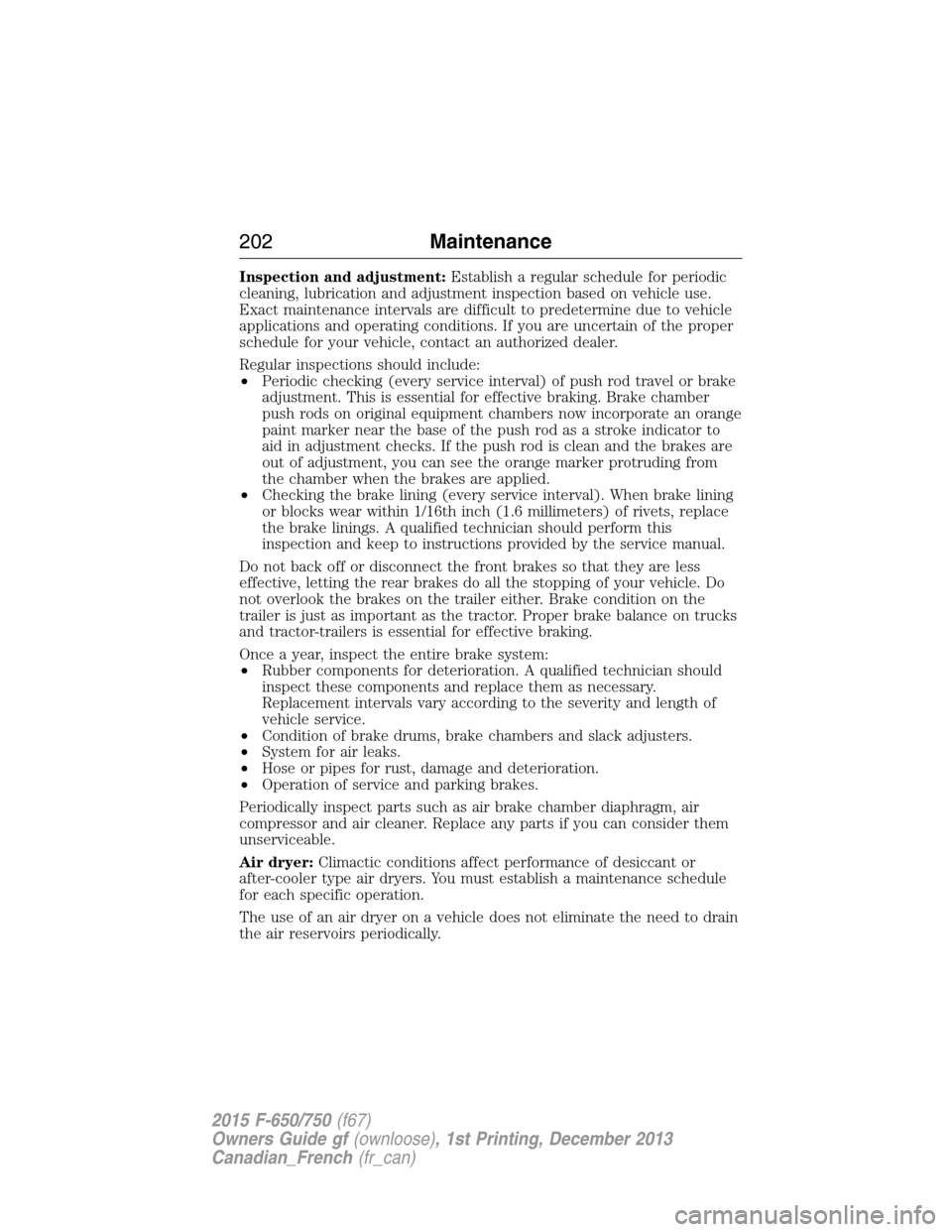
Inspection and adjustment:Establish a regular schedule for periodic
cleaning, lubrication and adjustment inspection based on vehicle use.
Exact maintenance intervals are difficult to predetermine due to vehicle
applications and operating conditions. If you are uncertain of the proper
schedule for your vehicle, contact an authorized dealer.
Regular inspections should include:
•Periodic checking (every service interval) of push rod travel or brake
adjustment. This is essential for effective braking. Brake chamber
push rods on original equipment chambers now incorporate an orange
paint marker near the base of the push rod as a stroke indicator to
aid in adjustment checks. If the push rod is clean and the brakes are
out of adjustment, you can see the orange marker protruding from
the chamber when the brakes are applied.
•Checking the brake lining (every service interval). When brake lining
or blocks wear within 1/16th inch (1.6 millimeters) of rivets, replace
the brake linings. A qualified technician should perform this
inspection and keep to instructions provided by the service manual.
Do not back off or disconnect the front brakes so that they are less
effective, letting the rear brakes do all the stopping of your vehicle. Do
not overlook the brakes on the trailer either. Brake condition on the
trailer is just as important as the tractor. Proper brake balance on trucks
and tractor-trailers is essential for effective braking.
Once a year, inspect the entire brake system:
•Rubber components for deterioration. A qualified technician should
inspect these components and replace them as necessary.
Replacement intervals vary according to the severity and length of
vehicle service.
•Condition of brake drums, brake chambers and slack adjusters.
•System for air leaks.
•Hose or pipes for rust, damage and deterioration.
•Operation of service and parking brakes.
Periodically inspect parts such as air brake chamber diaphragm, air
compressor and air cleaner. Replace any parts if you can consider them
unserviceable.
Air dryer:Climactic conditions affect performance of desiccant or
after-cooler type air dryers. You must establish a maintenance schedule
for each specific operation.
The use of an air dryer on a vehicle does not eliminate the need to drain
the air reservoirs periodically.
202Maintenance
2015 F-650/750(f67)
Owners Guide gf(ownloose), 1st Printing, December 2013
Canadian_French(fr_can)
Page 204 of 384
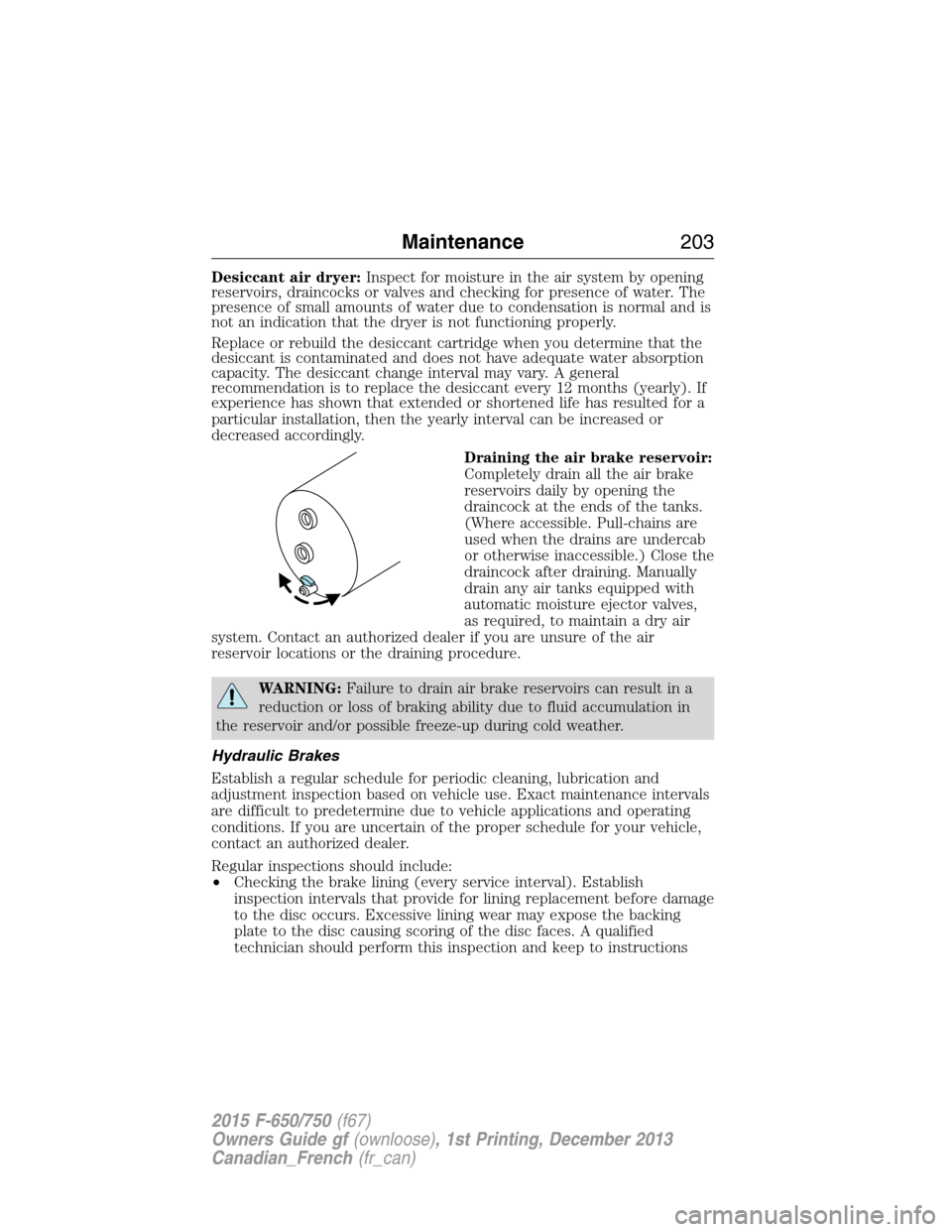
Desiccant air dryer:Inspect for moisture in the air system by opening
reservoirs, draincocks or valves and checking for presence of water. The
presence of small amounts of water due to condensation is normal and is
not an indication that the dryer is not functioning properly.
Replace or rebuild the desiccant cartridge when you determine that the
desiccant is contaminated and does not have adequate water absorption
capacity. The desiccant change interval may vary. A general
recommendation is to replace the desiccant every 12 months (yearly). If
experience has shown that extended or shortened life has resulted for a
particular installation, then the yearly interval can be increased or
decreased accordingly.
Draining the air brake reservoir:
Completely drain all the air brake
reservoirs daily by opening the
draincock at the ends of the tanks.
(Where accessible. Pull-chains are
used when the drains are undercab
or otherwise inaccessible.) Close the
draincock after draining. Manually
drain any air tanks equipped with
automatic moisture ejector valves,
as required, to maintain a dry air
system. Contact an authorized dealer if you are unsure of the air
reservoir locations or the draining procedure.
WARNING:Failure to drain air brake reservoirs can result in a
reduction or loss of braking ability due to fluid accumulation in
the reservoir and/or possible freeze-up during cold weather.
Hydraulic Brakes
Establish a regular schedule for periodic cleaning, lubrication and
adjustment inspection based on vehicle use. Exact maintenance intervals
are difficult to predetermine due to vehicle applications and operating
conditions. If you are uncertain of the proper schedule for your vehicle,
contact an authorized dealer.
Regular inspections should include:
•Checking the brake lining (every service interval). Establish
inspection intervals that provide for lining replacement before damage
to the disc occurs. Excessive lining wear may expose the backing
plate to the disc causing scoring of the disc faces. A qualified
technician should perform this inspection and keep to instructions
Maintenance203
2015 F-650/750(f67)
Owners Guide gf(ownloose), 1st Printing, December 2013
Canadian_French(fr_can)
Page 205 of 384
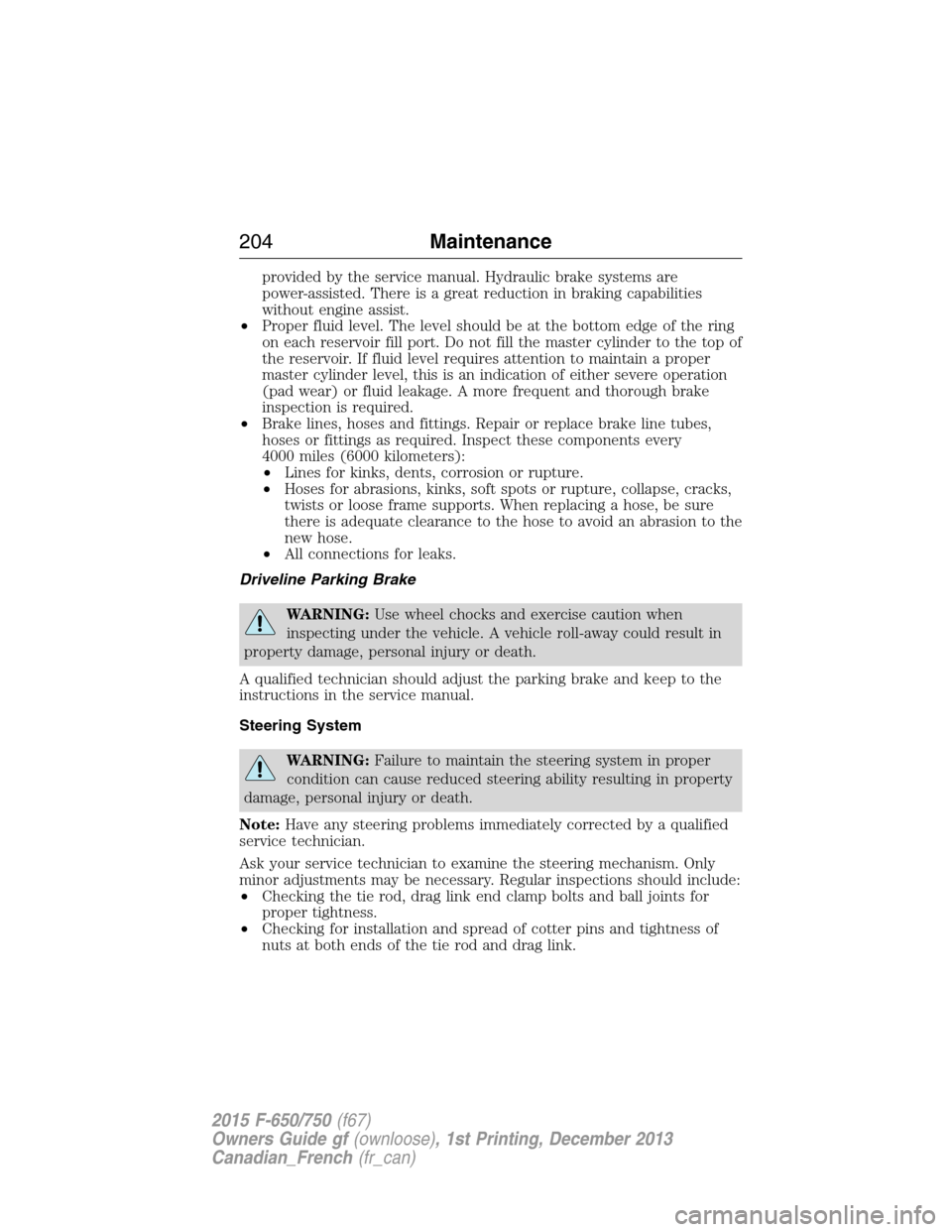
provided by the service manual. Hydraulic brake systems are
power-assisted. There is a great reduction in braking capabilities
without engine assist.
•Proper fluid level. The level should be at the bottom edge of the ring
on each reservoir fill port. Do not fill the master cylinder to the top of
the reservoir. If fluid level requires attention to maintain a proper
master cylinder level, this is an indication of either severe operation
(pad wear) or fluid leakage. A more frequent and thorough brake
inspection is required.
•Brake lines, hoses and fittings. Repair or replace brake line tubes,
hoses or fittings as required. Inspect these components every
4000 miles (6000 kilometers):
•Lines for kinks, dents, corrosion or rupture.
•Hoses for abrasions, kinks, soft spots or rupture, collapse, cracks,
twists or loose frame supports. When replacing a hose, be sure
there is adequate clearance to the hose to avoid an abrasion to the
new hose.
•All connections for leaks.
Driveline Parking Brake
WARNING:Use wheel chocks and exercise caution when
inspecting under the vehicle. A vehicle roll-away could result in
property damage, personal injury or death.
A qualified technician should adjust the parking brake and keep to the
instructions in the service manual.
Steering System
WARNING:Failure to maintain the steering system in proper
condition can cause reduced steering ability resulting in property
damage, personal injury or death.
Note:Have any steering problems immediately corrected by a qualified
service technician.
Ask your service technician to examine the steering mechanism. Only
minor adjustments may be necessary. Regular inspections should include:
•Checking the tie rod, drag link end clamp bolts and ball joints for
proper tightness.
•Checking for installation and spread of cotter pins and tightness of
nuts at both ends of the tie rod and drag link.
204Maintenance
2015 F-650/750(f67)
Owners Guide gf(ownloose), 1st Printing, December 2013
Canadian_French(fr_can)
Page 206 of 384
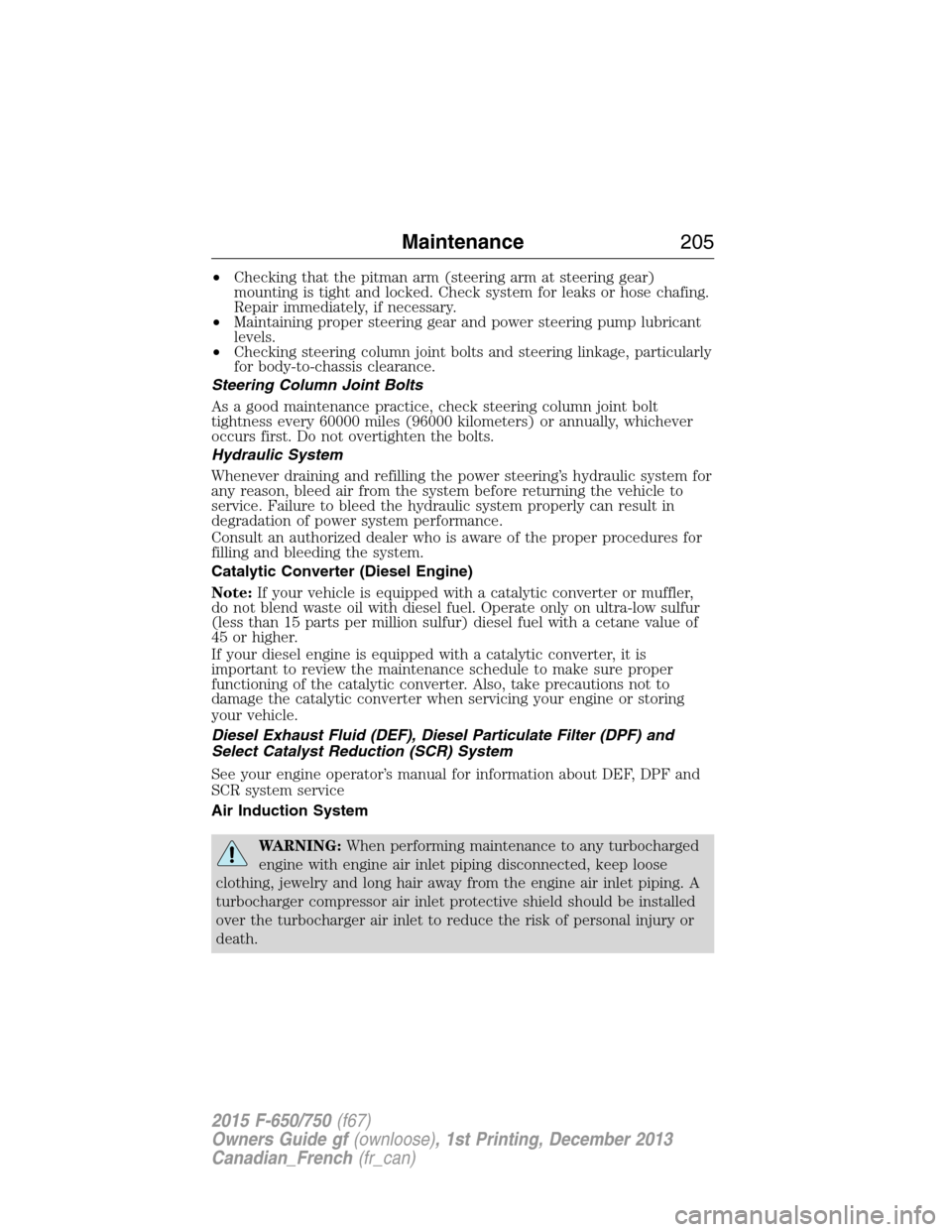
•Checking that the pitman arm (steering arm at steering gear)
mounting is tight and locked. Check system for leaks or hose chafing.
Repair immediately, if necessary.
•Maintaining proper steering gear and power steering pump lubricant
levels.
•Checking steering column joint bolts and steering linkage, particularly
for body-to-chassis clearance.
Steering Column Joint Bolts
As a good maintenance practice, check steering column joint bolt
tightness every 60000 miles (96000 kilometers) or annually, whichever
occurs first. Do not overtighten the bolts.
Hydraulic System
Whenever draining and refilling the power steering’s hydraulic system for
any reason, bleed air from the system before returning the vehicle to
service. Failure to bleed the hydraulic system properly can result in
degradation of power system performance.
Consult an authorized dealer who is aware of the proper procedures for
filling and bleeding the system.
Catalytic Converter (Diesel Engine)
Note:If your vehicle is equipped with a catalytic converter or muffler,
do not blend waste oil with diesel fuel. Operate only on ultra-low sulfur
(less than 15 parts per million sulfur) diesel fuel with a cetane value of
45 or higher.
If your diesel engine is equipped with a catalytic converter, it is
important to review the maintenance schedule to make sure proper
functioning of the catalytic converter. Also, take precautions not to
damage the catalytic converter when servicing your engine or storing
your vehicle.
Diesel Exhaust Fluid (DEF), Diesel Particulate Filter (DPF) and
Select Catalyst Reduction (SCR) System
See your engine operator’s manual for information about DEF, DPF and
SCR system service
Air Induction System
WARNING:When performing maintenance to any turbocharged
engine with engine air inlet piping disconnected, keep loose
clothing, jewelry and long hair away from the engine air inlet piping. A
turbocharger compressor air inlet protective shield should be installed
over the turbocharger air inlet to reduce the risk of personal injury or
death.
Maintenance205
2015 F-650/750(f67)
Owners Guide gf(ownloose), 1st Printing, December 2013
Canadian_French(fr_can)
Page 207 of 384
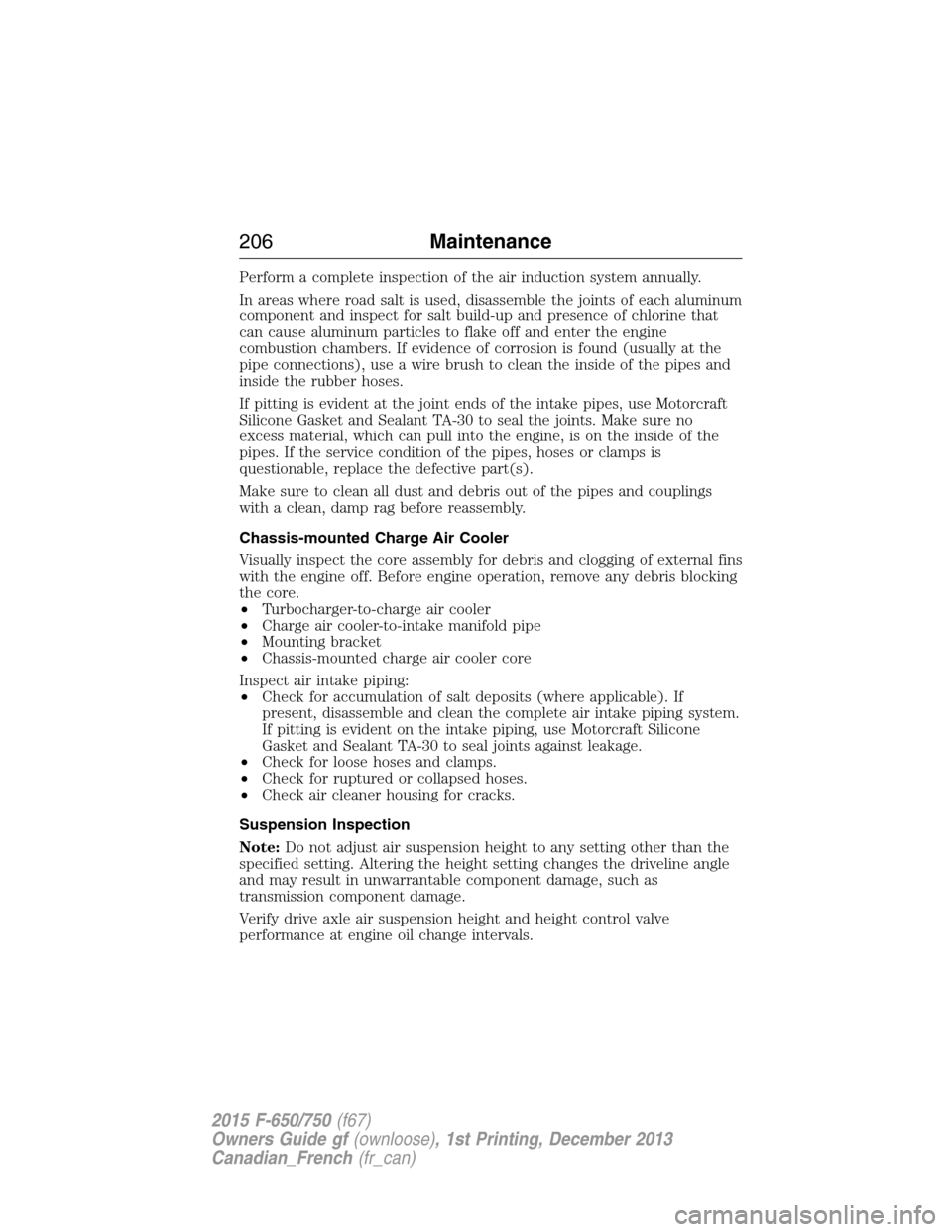
Perform a complete inspection of the air induction system annually.
In areas where road salt is used, disassemble the joints of each aluminum
component and inspect for salt build-up and presence of chlorine that
can cause aluminum particles to flake off and enter the engine
combustion chambers. If evidence of corrosion is found (usually at the
pipe connections), use a wire brush to clean the inside of the pipes and
inside the rubber hoses.
If pitting is evident at the joint ends of the intake pipes, use Motorcraft
Silicone Gasket and Sealant TA-30 to seal the joints. Make sure no
excess material, which can pull into the engine, is on the inside of the
pipes. If the service condition of the pipes, hoses or clamps is
questionable, replace the defective part(s).
Make sure to clean all dust and debris out of the pipes and couplings
with a clean, damp rag before reassembly.
Chassis-mounted Charge Air Cooler
Visually inspect the core assembly for debris and clogging of external fins
with the engine off. Before engine operation, remove any debris blocking
the core.
•Turbocharger-to-charge air cooler
•Charge air cooler-to-intake manifold pipe
•Mounting bracket
•Chassis-mounted charge air cooler core
Inspect air intake piping:
•Check for accumulation of salt deposits (where applicable). If
present, disassemble and clean the complete air intake piping system.
If pitting is evident on the intake piping, use Motorcraft Silicone
Gasket and Sealant TA-30 to seal joints against leakage.
•Check for loose hoses and clamps.
•Check for ruptured or collapsed hoses.
•Check air cleaner housing for cracks.
Suspension Inspection
Note:Do not adjust air suspension height to any setting other than the
specified setting. Altering the height setting changes the driveline angle
and may result in unwarrantable component damage, such as
transmission component damage.
Verify drive axle air suspension height and height control valve
performance at engine oil change intervals.
206Maintenance
2015 F-650/750(f67)
Owners Guide gf(ownloose), 1st Printing, December 2013
Canadian_French(fr_can)
Page 208 of 384
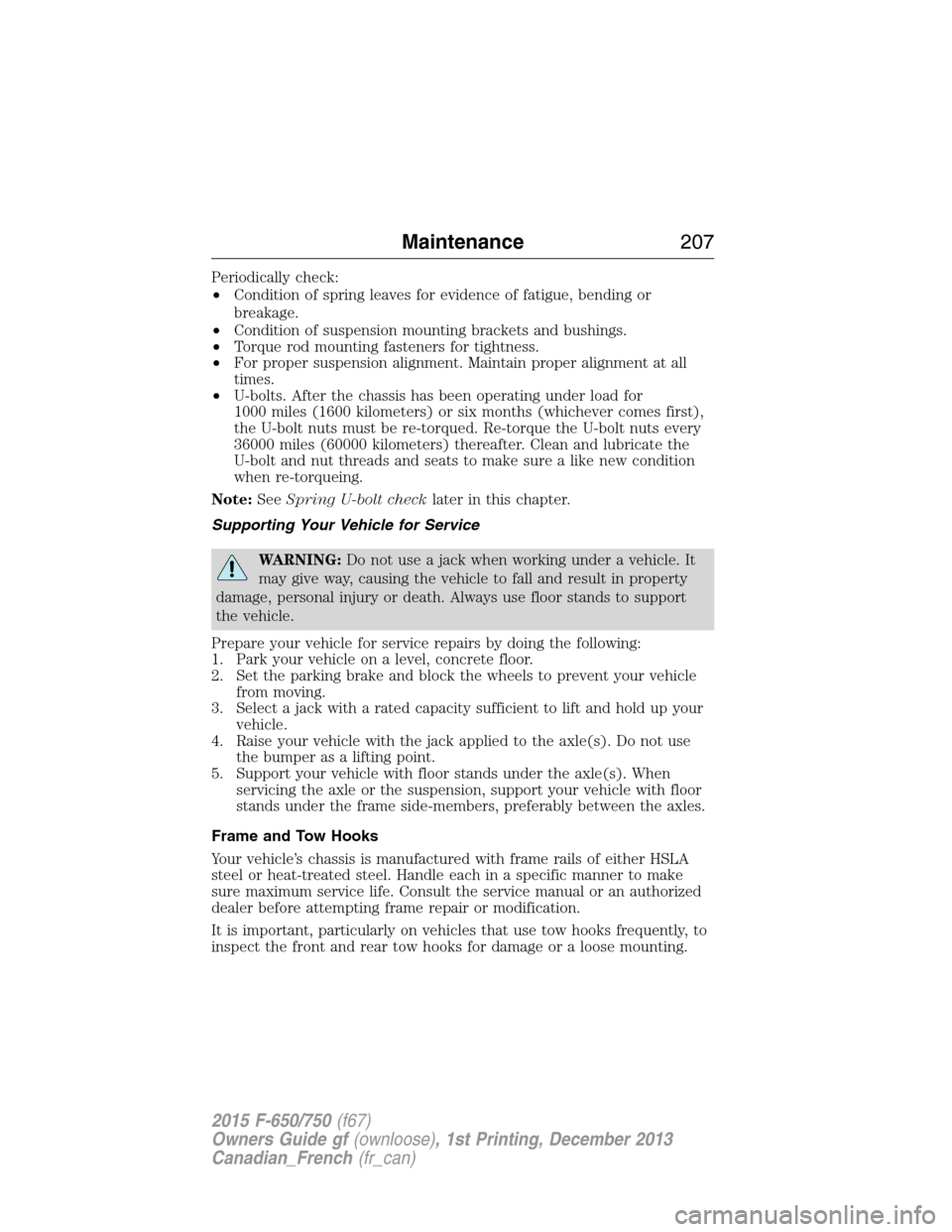
Periodically check:
•Condition of spring leaves for evidence of fatigue, bending or
breakage.
•Condition of suspension mounting brackets and bushings.
•Torque rod mounting fasteners for tightness.
•For proper suspension alignment. Maintain proper alignment at all
times.
•U-bolts. After the chassis has been operating under load for
1000 miles (1600 kilometers) or six months (whichever comes first),
the U-bolt nuts must be re-torqued. Re-torque the U-bolt nuts every
36000 miles (60000 kilometers) thereafter. Clean and lubricate the
U-bolt and nut threads and seats to make sure a like new condition
when re-torqueing.
Note:SeeSpring U-bolt checklater in this chapter.
Supporting Your Vehicle for Service
WARNING:Do not use a jack when working under a vehicle. It
may give way, causing the vehicle to fall and result in property
damage, personal injury or death. Always use floor stands to support
the vehicle.
Prepare your vehicle for service repairs by doing the following:
1. Park your vehicle on a level, concrete floor.
2. Set the parking brake and block the wheels to prevent your vehicle
from moving.
3. Select a jack with a rated capacity sufficient to lift and hold up your
vehicle.
4. Raise your vehicle with the jack applied to the axle(s). Do not use
the bumper as a lifting point.
5. Support your vehicle with floor stands under the axle(s). When
servicing the axle or the suspension, support your vehicle with floor
stands under the frame side-members, preferably between the axles.
Frame and Tow Hooks
Your vehicle’s chassis is manufactured with frame rails of either HSLA
steel or heat-treated steel. Handle each in a specific manner to make
sure maximum service life. Consult the service manual or an authorized
dealer before attempting frame repair or modification.
It is important, particularly on vehicles that use tow hooks frequently, to
inspect the front and rear tow hooks for damage or a loose mounting.
Maintenance207
2015 F-650/750(f67)
Owners Guide gf(ownloose), 1st Printing, December 2013
Canadian_French(fr_can)
Page 209 of 384
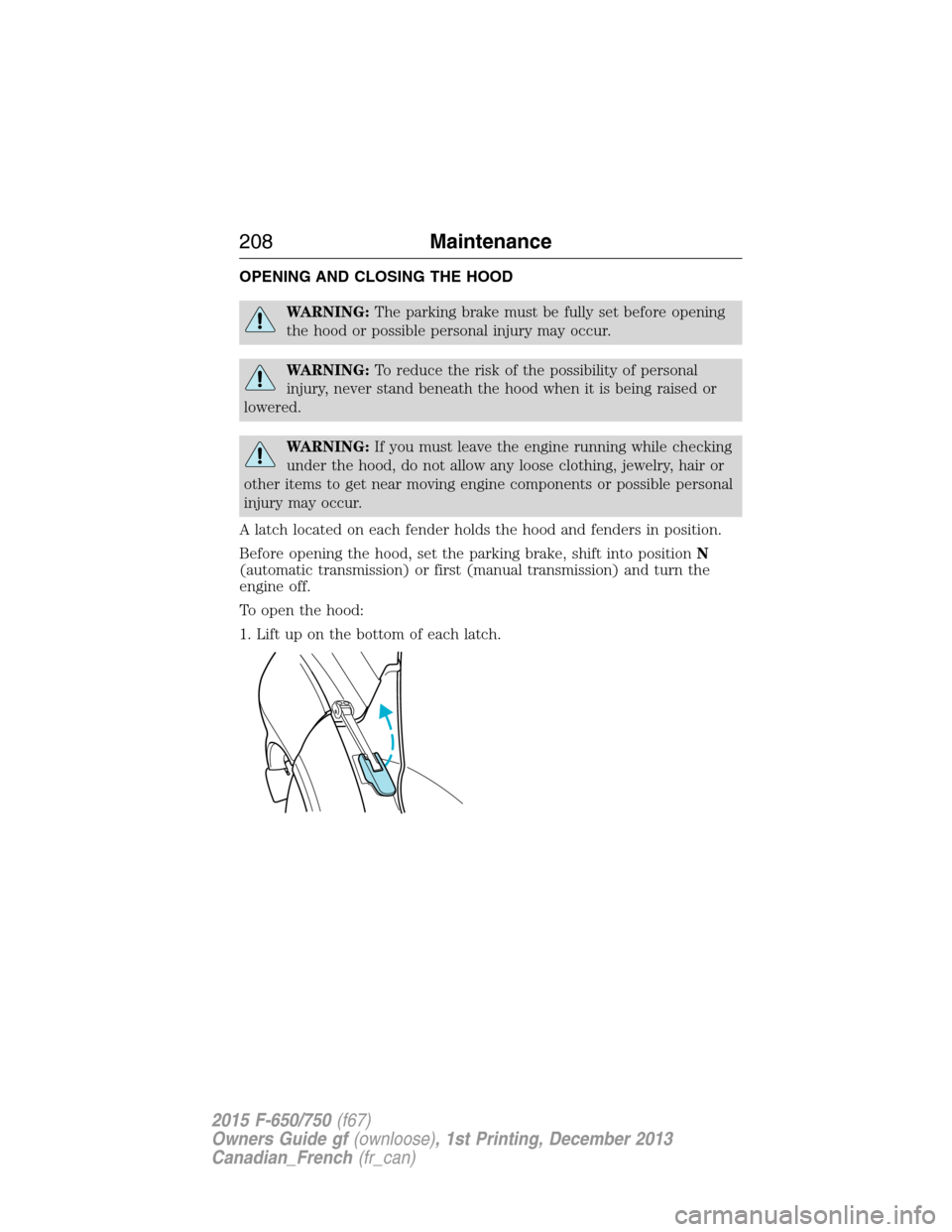
OPENING AND CLOSING THE HOOD
WARNING:The parking brake must be fully set before opening
the hood or possible personal injury may occur.
WARNING:To reduce the risk of the possibility of personal
injury, never stand beneath the hood when it is being raised or
lowered.
WARNING:If you must leave the engine running while checking
under the hood, do not allow any loose clothing, jewelry, hair or
other items to get near moving engine components or possible personal
injury may occur.
A latch located on each fender holds the hood and fenders in position.
Before opening the hood, set the parking brake, shift into positionN
(automatic transmission) or first (manual transmission) and turn the
engine off.
To open the hood:
1. Lift up on the bottom of each latch.
208Maintenance
2015 F-650/750(f67)
Owners Guide gf(ownloose), 1st Printing, December 2013
Canadian_French(fr_can)
Page 210 of 384
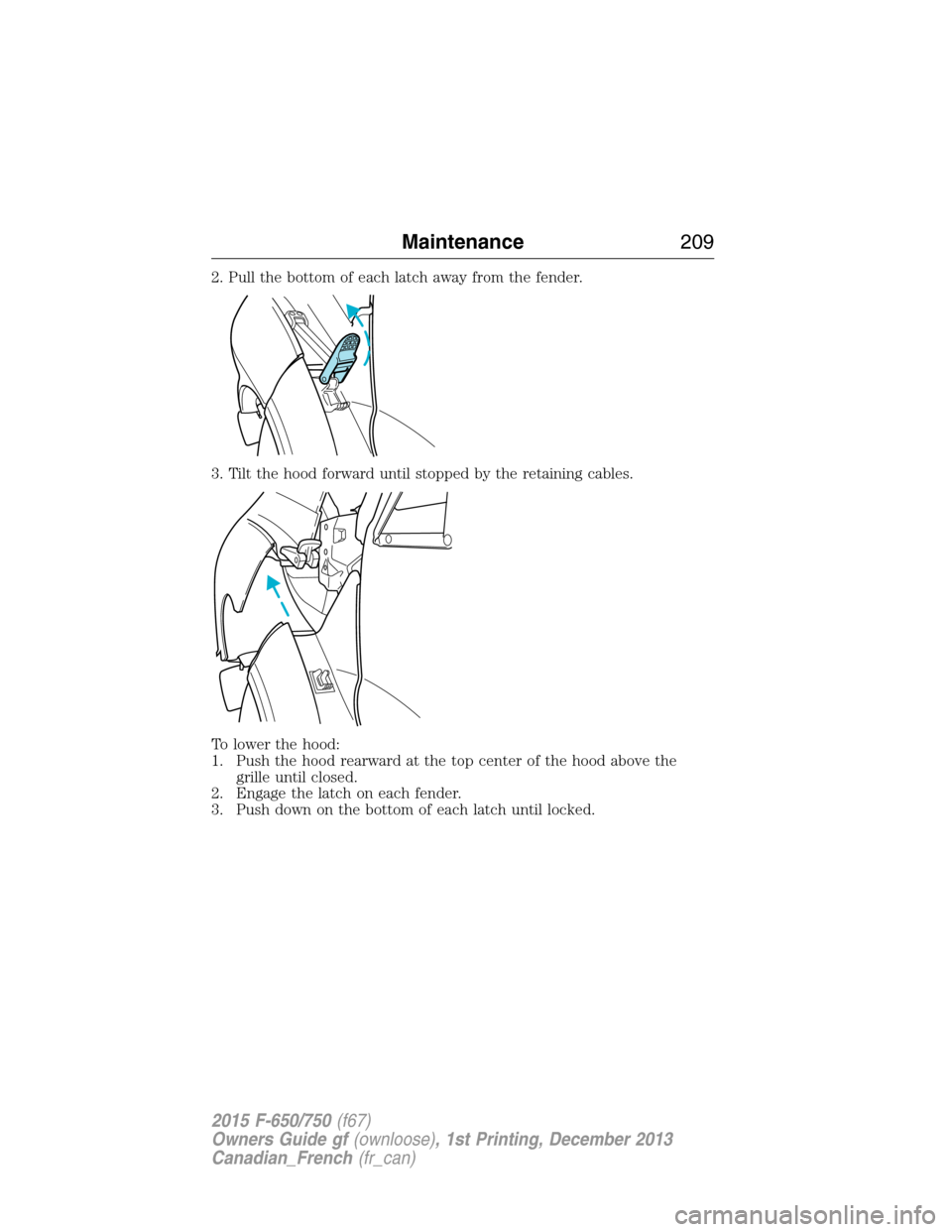
2. Pull the bottom of each latch away from the fender.
3. Tilt the hood forward until stopped by the retaining cables.
To lower the hood:
1. Push the hood rearward at the top center of the hood above the
grille until closed.
2. Engage the latch on each fender.
3. Push down on the bottom of each latch until locked.
Maintenance209
2015 F-650/750(f67)
Owners Guide gf(ownloose), 1st Printing, December 2013
Canadian_French(fr_can)